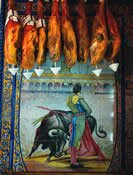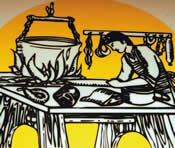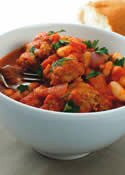Inflight Magazine of Brussels Airlines
Welcome to the Inflight Magazine of Brussels Airlines
Hamming it up
Spanish ham is something of a national treasure, so what better way to explore the country than by heading out on the trail of its most exclusive jamón? Heidi Fuller-love puts her best trotter forward
Images Alamy, Heidi Fuller-love, photolibrary.com.
 Hanging ham hocks click heels together in the whistling sierra wind as I pull into Montefrio ranch (El Repilado, tel. ), an hour’s drive from Seville, where I will spend the night. Set in the heart of the 184,000-hectare Sierra de Aracena natural park, which extends from the clifftop town of Zufre to Aroche near the Portuguese border, it’s surrounded by a forest of crinkle-leaved holm oaks – providing an ideal environment for raising charcoal-hoofed pata negra pigs.
Hanging ham hocks click heels together in the whistling sierra wind as I pull into Montefrio ranch (El Repilado, tel. ), an hour’s drive from Seville, where I will spend the night. Set in the heart of the 184,000-hectare Sierra de Aracena natural park, which extends from the clifftop town of Zufre to Aroche near the Portuguese border, it’s surrounded by a forest of crinkle-leaved holm oaks – providing an ideal environment for raising charcoal-hoofed pata negra pigs.
Descended from the wild boar, pata negras are bred to produce jamón ibérico de bellota (bellota means acorn) – ham’s equivalent of caviar – which has seduced celebrity chefs ranging from the UK’s Jason Atherton to Gallic food artiste Alain Ducasse. In the bright July sunlight I watch the animals pirouetting on their pointed toes like ballerinas as they reach up to snaffle leaves from branches overhead. “In August the acorns will start falling and we estimate that each pig will eat 500kg of the nuts,” explains ranch owner Armando Perez.
 Meat the experts
Meat the experts
Half an hour’s drive northwest of the ranch is the town of Jabugo, famous as the centre of jamón ibérico production. A rather charmless place in itself, it’s worth a visit for Sánchez Romero Carvajal (Carretera de San Juan del Puerto, tel. ), the region’s biggest ham factory and curing bodega. When we meet in a 19th-century colonnaded courtyard the following afternoon, Manuel Zalvide, the company’s maestro jamonero, leads me to a vast, dimly-lit room on the first floor, where the rafters are strung with several thousand hocks of maturing meat.
After being packed in sea salt to sweat, this is where the finest jamón ibérico de bellota is hung to dry for anywhere between 24 and 30 months. “The air in Jabugo is cold and dry by day, but humid at night; this is what gives exceptional flavour to our meat,” says Manuel. He punctures one of the hams with a splinter of bone, and a vaguely sweet, cheesy odour fills the air. “It’s the smell that tells us if the ham is ripe,” he explains.
I spend the night at the Finca La Silladilla (Los Romeros, tel. ), an Iberian pig ranch just outside Jabugo. Furnished with an eclectic mix of Spanish antiques and travel mementos, the ranch is surrounded by dense cork oak forest and has a small shop selling local wines and homemade jamón de bellota.
 Hidden depths
Hidden depths
The largest town in the Sierra de Aracena region, Aracena is dominated by the impressive remains of its Moorish castle and is packed with emporiums selling everything from ham hocks to ceramic ashtrays. It’s best known, however, for its caves, the Gruta de las Maravillas (Plaza Pozo de Nieves, tel. ).
So, ducking out of burning heat above ground the following morning, I spend a blissful hour exploring this labyrinth of caverns, dramatic limestone formations and crystalline pools, discovered in 1886 by a swineherd hunting for one of his lost pigs.
At José Vicente (53 Avenida de Andalucía, tel. ), a restaurant in the centre of town that’s renowned for pork-based cuisine, I lunch on feather-thin slices of Sánchez Romero Carvajal’s rich and nutty, 36-month cured Cinco Jotas, followed by slabs of creamy torta de Aracena goats’ cheese. I wash it all down with a small tumbler of the local vanilla-flavoured acorn liqueur, licor de bellota.
 Fat chance
Fat chance
After a peaceful night’s slumber at Finca Buen Vino (Los Marines, tel. , www.fincabuenvino.com), a delightful Scottish-run farmhouse bed and breakfast a 10-minute drive from Aracena, I meander along a potholed country road, through rolling countryside dotted with grazing pigs, to the lively little ham-producing village of Cortegana. Here I visit the Lazo ham factory (6 Avenida de Portugal, tel. ) and learn that it’s the Iberian pig’s unusual metabolism, which allows fat to permeate into its muscles, that gives jamón ibérico its marbled quality.
The picturesque village next door, Almonaster la Real, is an ideal place to stroll to work up an appetite, with its 10th-century red-brick mosque and panoramic views over the sierra. I dine that evening at Las Palmeras (tel. ), a cosy eatery serving hearty local fare including sopa de Castaño – a sapid stew made with boiled chestnuts – and pork from proprietor Alejandro González Vázquez’s own stock.
Back in Seville the next day, I follow the advice of Manuel Zalvide and head for Casa Roman (1 Plaza Venerables, tel. ), an atmospheric locals’ bodega strung with ham hocks and old sepia-tinted oil paintings. Golden beads of fat glitter on a hock of pata negra hung above the bar. “We say that a ham is good when it cries,” barman Javier confides as he serves me a tumbler of fino quinta sherry and deftly deals several dark-red, translucent slices of the ham on to my plate. As I take a bite of the nutty, melt-in-the-mouth meat, it’s so good that I feel like crying myself.
Still hungry?
Three other hot spots for a carnivore tour
 Palma de Mallorca
Palma de Mallorca
Sobrassada de Mallorca, a cured sausage paste made with ground pork, paprika and pepper, and butifarró (pork intestine filled with coarsely ground meat, spices and aniseed), are two of Mallorca’s specialities. To appreciate these delicacies at their finest, head to Restaurante Bruselas (4 Calle S’Estanc, tel. ), where you can dine on pierna de cordero rellena de sobrassada (pork loin stuffed with sobrassada) and calamar relleno con butifarró y Sobrassada (squid stuffed with butifarró and sobrassada).
Berlin
Currywurst, Berlin’s most popular sausage – served with a spicy curry and tomato sauce – can be found all over the German capital, but Konopke’s Imbiss (16 Romain-Rolland-Strasse, tel. ) is a real insider’s address for sampling this fleshy speciality – it’s a canteen-style eatery that’s been serving homemade currywurst for the past eight decades.
Toulouse
Renowned for its tasty meat dishes, this city’s specialities include the Toulouse sausage, goose confit and pork and white bean cassoulet. At lunchtime, head for the row of small restaurants serving lunch above the covered market (Marché Victor Hugo) to sample some gastronomic meat marvels. And when evening draws a veil over this vibrant, Spanish-style city, make a beeline for the Auberge Louis XIII (1 Rue Tripiere, tel. ) to sup on carnivorous delights.
FR Jambon de pays
En Espagne, le jambon est considéré comme une richesse nationale. Et prendre la route des jamón est une façon exclusive de partir à l’exploration du pays. Heidi Fuller-love enfourche sa meilleure monture….
Je démarre la journée au ranch de Montefrio (El Repilado, tél. ), à une heure de Séville dans le parc naturel de la Sierra de Aracena. Sa forêt de chênes constitue l’environnement pour l’élevage de porcs pata negra, qui produisent le jamón ibérico de bellota (bellota signifie gland) – l’équivalent du caviar dans l’univers des jambons.
À une demi-heure de route en direction du nord ouest, dans la ville de Jabugola, Sánchez Romero Carvajal (Carretera de San Juan del Puerto, tel. ) est un des plus grands producteurs de jambon de la région. C’est ici que les plus fins jamón ibériques sont mis à sécher selon une méthode naturelle entre 24 et 30 mois. « La journée, l’air est froid et sec, tandis que le soir il devient humide : des conditions qui apportent une saveur exceptionnelle, » explique Manuel Zalvide.
À Aracena, la plus grande ville de la région, je déjeune chez José Vicente (53 Avenida de Andalucía, tél. ). Au menu, des tranches ultra fines de “5 Jotas” du producteur Sánchez Romero Carvajal. Ce jambon riche, affiné pendant 36 mois, est considéré comme le nec plus ultra. Buvez ensuite une liqueur locale de bellota.
Dans le village de Cortegana, également grand producteur de jambon, une visite à l’usine de Lazo (6 Avenida de Portugal, tél. ) m’apprend que le métabolisme des cochons ibériques, en permettant l’écoulement de la graisse dans les fibres musculaires, donne au jambon de la péninsule cet aspect marbré. Dans le village voisin, à Almonaster la Real, je dîne à Las Palmeras (tél. ) d’un plat de porc issu du propre élevage du propriétaire. De retour à Séville, je rejoins la Casa Roman (1 Plaza Venerables, tél. ), une cave d’où se dégage une atmosphère authentique. « Chez nous, on dit qu’un jambon est bon lorsqu’il pleure, » nous confie le barman Javier, en m’apportant une assiette ornée de quelques fines tranches. Lorsque je prends ma première bouchée, elle est si délicieusement fondante qu’à mon tour j’en ai les larmes aux yeux.
NL In het spoor van de ham
Spaanse ham wordt nagenoeg beschouwd als een nationale schat. Dus: hoe beter het land te ontdekken dan door het volgen van het spoor van zijn meest exclusieve jamón? Heidi Fuller-love zet haar beste beentje voor
Ik start mijn reis bij de Montefrio ranch (El Repilado, tel. ), gelegen op een uurtje van Sevilla in de bergen van het natuurpark van Aracena. De talrijke eikenbomen bieden de ideale omgeving voor het kweken van jamón ibérico de bellota (bellota betekent eikel) – de kaviaar der hammen.
Een halfuurtje naar het noordwesten vind je in het stadje Jabugo Sánchez Romero Carvajal (Carretera de San Juan del Puerto, tel. ), de grootste hamfabriek uit de streek. Hier wordt de allerfijnste jamón ibérico tussen 24 en 30 maanden voor rijping opgehangen. “Overdag is de lucht koud en droog , maar ’s nachts is hij vochtig, wat deze ham zijn bijzondere smaak bezorgt”, aldus Manuel Zalvide. In Aracena, de grootste stad van de streek, lunch ik bij José Vicente (53 Avenida de Andalucía, tel. ). Ik geniet er van flinterdunne plakjes van de heerlijke, naar noten smakende Cinco Jotas ham van bij Sánchez Romero Carvajal. Het resultaat van een rijpingsproces van 36 maanden. Ik spoel tot slot weg met de plaatselijke licor de bellota.
In de hamproductiestad Cortegana bezoek ik de Lazo hamfabriek (6 Avenida de Portugal, tel. ), waar ik ontdek dat de uitzonderlijke kwaliteit van de jamón ibérico het gevolg is van het metabolisme van het varken, dat toelaat het vet op te slaan in de spieren. In buurstadje Almonaster la Real diner ik bij Las Palmeras (tel. ). Ik proef er van het varken uit de stal van de eigenaar. Terug in Sevilla breng ik een bezoekje aan Casa Roman (1 Plaza Venerables, tel. ), een sfeervolle bodega waar veel locals komen. “We zeggen dat een ham goed is als hij huilt”, vertrouwt barman Javier me toe terwijl hij bedreven verschillende plakjes op mijn bord legt. Al van bij de eerste hap van dit vlees dat zo wegsmelt in je mond, vind ik dit zo lekker dat ikzelf er al van zou gaan huilen.
Leave a Reply
